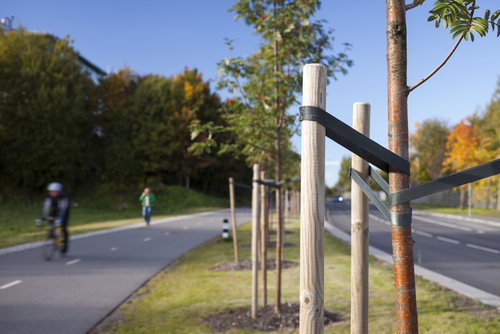Staking: A Tree Service Company Knows Best

Staking: A Tree Service Company Knows Best
Keep in mind, our tree service company wants you to keep healthy trees around your property. Preventive maintenance is key.
Did you just plant a new tree in your yard in Hagerstown or Frederick Md? Does it appear to be unsteady? Do you think it might blow over or snap if a high gust of wind comes a long? If so, you might want consider staking your new tree to assist it in putting down strong firm roots, to keep the new life anchored into the ground.
Staking a tree is necessary when a newly planted sapling needs extra support. It can only help giving it a little extra boost of protection from the elements and small animals.
When Should I Stake?
Some trees need to be staked, while others do not. If you have a new tree that has a small root ball or bare roots, or that is planted near a sidewalk or driveway, then you are going to want to stake your tree. Coming out of the nursery, it has not had time to grow strong roots and will need extra support until it does. If you notice your newly planted tree is starting to lean, make sure to stake it. If your sapling has more foliage at the top, making it top heavy, or it has no lower branches, you need to stake it to the Earth. Also, make sure to stake particular kinds of trees such as Eucalyptus and Oleander trees. In addition, note your area. If you have high winds or wet soil, you need to stake your new tree for extra support and protection.
How To Stake For Support
When you have a new little tree that requires some additional help, you need to stake it into the ground. To do this correctly, you need to purchase two to three metal or wooden stakes and have them handy. Set your tree upright by placing your hand at the base to see where it needs to be steadied. This is how tall your stakes will be as this is the extra amount of supporting your sapling needs.
A good tree service company knows the stakes need to be placed at opposite sides with approximately a distance of one and a half feet from the trunk. Make sure to use a soft material when staking your tree. There are specially made tree-staking straps you can purchase which will not harm the tree as it grows. Our tree service company advices against using any wire or rope, as that will damage the trunk. Also, make sure to leave a little slack in the straps so the tree can sway naturally. You do not want it forcefully tight as this can also damage the sapling.
Length Of Time To Keep The Tree Staked
Usually, a tree only needs to be staked for the first season. By then, the roots have spread out and grown in and have taken hold of the ground below. This allows the tree to have much more support and balance in high winds. If you place your stake in the spring, then remove it in the fall. If you do not, the tree becomes dependent on the stake and will not stand on its own.
Why Would I Want To Place A Tree Stake On My New Sapling?
Some trees do not need to be staked. If you have a tree that has a solid, sturdy trunk or base and has a robust root system, most likely, you will not need to stake that tree. You also do not need to stake trees that have branches that are low to the ground, or conifer or evergreens trees. This is due to having better balance with high winds. If you have a tree that has a small root ball, a top-heavy tree, loose or wet soil, or a tree near a sidewalk or street, then you do need to stake your tree. By following the information presented, your new sapling will grow up to be one of the tallest and sturdiest trees on your property!

